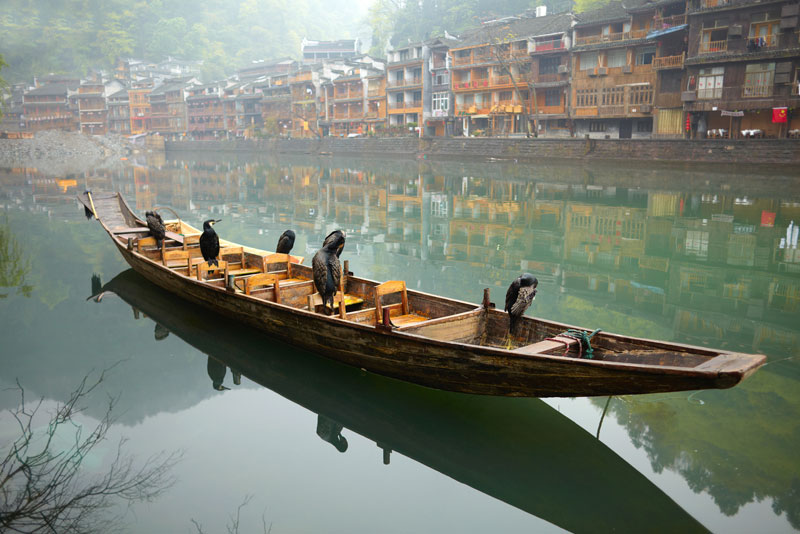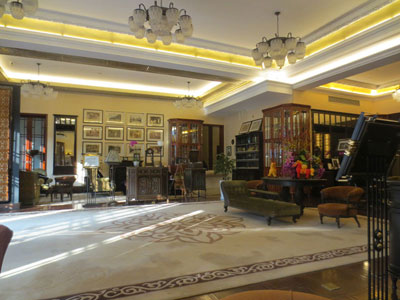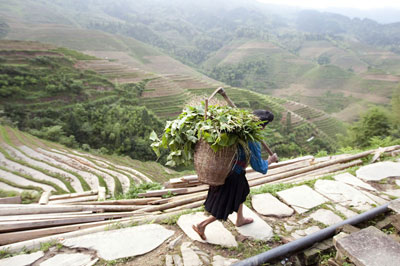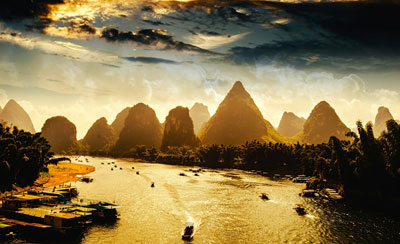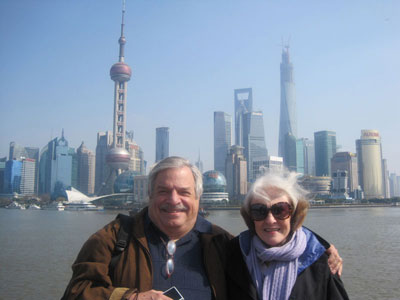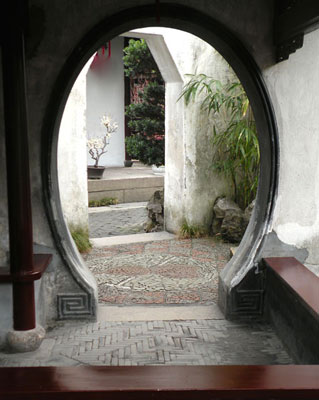A serendipitous stay in Shanghai
This article appears on page 6 of the February 2015 issue.
During a phone conversation with my longtime buddy Jimmy, I was introduced to a website, LuxuryLink.com, that offers deals on upscale hotels and rental properties around the world. So when planning the latest trip for my wife, Rita, and myself, I visited the site and set about finding a lovely hotel in a faraway land.
Tucked away at the bottom of the website was a link to a “Mystery Auction.” “What could that be?” I thought to myself.
Exploring further, I learned that the site offered hints of properties available for rent, listing for each a general location and pictures of a skyline — but not the hotel’s name — and a starting bid price.
The first one I looked at listed the location as “Eastern Asia” and included a picture of a skyline that I knew at first glance was Shanghai, China.
Noting that Luxury Link seemed to feature notably good to excellent properties, I guessed this would be of similar quality and entered a bid of $301 for a 3-night stay for any time in February 2014.
After a bit of back and forth, my final bid of $501 ultimately sealed our early 2014 travel plans. We were headed to Shanghai!
Making plans
This was the first time in all our travel life that we allowed a hotel choice to dictate our chosen destination. I contacted China Travel Service in San Francisco (800/899-8918, www.chinatravelservice.com), a company we had used on a prior trip and with which we were pleased.
A helpful Vera became my travel guru, assisting me in the setup of a 15-day program featuring visits to Shanghai, Guilin and Kunming. The total package price for the two of us, including internal airfare, was $4,000. Our international air and the three nights’ hotel were extra.
After landing in Shanghai and clearing the almost nonexistent Customs area, we saw Edwin, who would be our guide for the next four days, waving his sign with “Rita and Larry Kritcher” written on it.
As we drove away from the airport, we couldn’t help but notice the silence of the huge city. There were few street noises, even though the highways were busy. Edwin explained that many vehicles were powered by either natural gas or electricity and that honking your horn was unlawful, except to avoid an accident.
Edwin escorted us to the ultramodern Metropole Hotel, as our Luxury Link hotel reservations did not begin until the following night. We rapidly fell from a hot shower into a deep sleep after a long day of travel from the other side of the Earth.
Seeing some sights
Cheery Edwin had a gentle morning planned for our first day of touring Shanghai. We spent a splendid morning at Yu Garden, built during the Ming Dynasty.
This picture-perfect man-made park is a marvel of engineering. After wandering through gardens and across bridges, past shrines and art galleries, I realized that my GPS had not moved very much.
Disguised arches, bends and doors led us to think we had covered miles of gardens when, in fact, we had been traveling in a spiral. We popped out hours later virtually where we entered, never having seen the same dragon, temple or lantern twice.
This visit is way up there on our list of Shanghai highlights.
Next we walked in the People’s Park, which was once a racetrack. On weekends, it turns into a marriage market, where mothers and fathers pin written profiles on opened umbrellas about the availability of their daughters, bragging about their strength, beauty, heritage and schooling. Occasionally, a young lad’s biography would surface among them.
Edwin said the practice works well. The event was so crowded with participants that it was a tortuous walk through the park.
Moving on
At the end of our busy first day, Edwin took us to the Mansion Hotel, where I had won our stay in the Luxury Link auction. The hotel was located in the French Concession area of the city, touted to be an above-market shopping area boasting fine restaurants. Across the street was the Grape Restaurant, highlighted in several guidebooks.
We hadn’t traveled so far to spend our limited time in town shopping, so that part fell by the wayside, but we did plan to eat, to try new foods in a foreign land.
The hotel, itself, was a pre-WWII structure with antiques throughout. There were old, patina-framed photographs from floor to ceiling, and the ceilings were high. It had a certain vintage charm about it, but it fell short of some of our expectations — especially when we discovered that the rooftop bar and restaurant, highly touted by Luxury Link, was closed due to construction.
Since we were in the French Concession, we tried a French-Chinese restaurant for our first evening meal. It was satisfactory, but I don’t remember what I ate. I do remember that it was so expensive that I would much rather munch Chinese takeout sitting on the curb before I’d go back.
Museum visits
As we moved into our second day, an intermittent rain began. Hello, museum day!
The Shanghai Museum is four floors of China’s glorious artistic past. There are 120,000 exhibits, and I think Rita examined every one of them. I secretly admired her intense thirst for a third-century-BC segment of parchment decorated by wasp-wing imprints in indigo and shaded by a filigree of matching purple, with nuances of ochre mud dug from the banks of a river that had dried up 40,000 years ago.
There were galleries featuring bronzes, ceramics, calligraphy, furniture, jade, sculptures and coins plus exhibits on the various ethnic minorities living within China.
That evening we ventured into the Grape Restaurant. The menu, written in Chinese and English, was a bit challenging. I loved that I could have ordered “gluttonous bullfrog; boiled slice bee; pan gas fry; confused ribs; celery yam fungus; spicy brain; chicken feet salad; crispy fried grasshoppers; fried stinky tofu; best duck casserole” (featuring the duck’s head), and a dessert of durian, the smelliest fruit in all of Asia. (Yes, I tried it; it was not as bad as anticipated, but I wouldn’t order it again.) Rita ate plain rice and salad with white wine.
We awakened to another drizzly morning, but, rain or shine, Edwin had his never-ending smile with him.
We really enjoyed the Folk Historic Museum, wherein the history of Shanghai was marvelously depicted. I think we could have spent days there. The miniature reconstruction of the downtown areas on the Bund, with the large boulevards and roads, like Nanking Road, was marvelous indeed!
Our last day in Shanghai took us on a car ride 50 kilometers west of the city to an ancient water town, Zhujiajiao. A labyrinth of intricate waterways connects much of eastern China, and this particular village, known for its bridges, was charming.
Guilin
It was time to move to the second phase of our trip, so we said good-bye to Edwin and took a 2-hour flight to Guilin. We were enticed there to visit the mountains and caves on the Li Jiang (jiang means “river”).
The city, itself, is concentrated around lakes and estuaries of the river, which flows 83 kilometers southward from Guilin to the town of Yangshuo.
Some 13 million people travel there each year for the scenery, according to our new, knowledgeable guide, Nick. Poets, artisans and painters have raved about the pinnacled mountains, the green ribbons of forest, the wispy branches of bamboo and the fishermen plying the river with their fish-catching cormorants.
First we went to the Reed Flute Cave. We welcomed the visit, which kept us out of the persistent rain.
The soft limestone in that part of China allowed nature to carve out some fantastic underground marvels. The caves were spectacular, with enormous caverns of stalactites and stalagmites. The walkways were very well paved, and the designers seemed to have a propensity to backlight, spotlight and rope-light everything, using primary colors — a little Disneyesque, perhaps. Nevertheless, we enjoyed the hour-long hike through the cool, damp air (before wandering back into the much damper rain).
A bit of trouble
In this area, we were staying at the Lijiang Waterfall Hotel, an older hotel that was an absolute ghost town; the only people we saw were staff. We knew February was off-season, but not this far off.
We made our way to an alley behind the hotel and found the Li Jiang restaurant. We felt more comfortable there than at our empty hotel dining room. I indulged in a roasted duck dinner, while Rita messed around with touches of rice, cucumber salad and chicken soup.
Our meal came to an end and I discovered that they did not take Visa, MasterCard or American Express. Our meal cost 300 yuan, about $50, but they would not accept dollars.
I was dispatched by the head waitress of our eating area to proceed a block away to a bank that had an ATM. I was accompanied by a young waitress to help guide me.
We quick-stepped through rain to the China Construction Bank (CCB) and entered the external kiosk where five machines beckoned. I chose the center one and proceeded to insert my Visa card and press “2” for instructions in English. When prompted, I entered my PIN. The machine then ate my card, issuing me a slip in English that said I could use the receipt to get my card back during banking hours. That would be the following day.
The poor waitress looked bewildered, and I threw my hands up in exasperation. We headed back to the restaurant with no money. By this time, the restaurant owner was present and knew our dilemma, stating in near-perfect English, “Of course, we will take US cash.” So we paid the $50 and were on our way.
The next afternoon we returned to the bank, with Nick as translator and me armed with my claim receipt. We proceeded directly to the centrally located lobby manager’s desk.
We presented the claim check to the young woman, and she just stared at the receipt before making a phone call.
She hung up and looked straight at Nick and said the card had not been found that morning when they checked the machines. She never looked at Rita or me. She suggested to Nick that I call Visa and cancel my card. As we needed this card for the remainder of our journey, and we had more than a week to go, we pleaded that they look in the machine again.
After much time was wasted with questions that could have all been answered by the information contained on the receipt she was given, the manager finally acquiesced to calling the specialist who had the key to each machine. Nick said we’d have to wait, since there was only one specialist and he handled all the banks in Guilin that belonged to CCB.
Minutes before closing, the man arrived with a battery of keys. He opened the machine and the card popped out.
With a sheepish look on her face, the manager finally made eye contact, handing the card to me.
I would suggest that no one should rely on a credit card for expenses in China, other than at a top hotel. Our primary tour operator would not even take a credit card. I had paid Vera in San Francisco by Visa, but any extensions to my prepaid tour arranged while in China had to be paid in cash, as did all guide services.
We had taken $800 between the two of us and had to hit the ATM for an extra $400, when we could find one that took Visa or MasterCard. I think the guides’ and drivers’ tips suffered a bit because we were anxious about running out of cash.
On to better things
Our night boat tour of the lakes and estuaries of the Li Jiang around Guilin was spectacular. The fishermen lined our route with their cormorants diving for fish from their owners’ small skiffs, which were lit by dimly glowing lanterns. (Regrettably, it was too dark for a really good photo.)
The tour wove its way along the colorful shrines, bridges and karst formations jutting upward from the riverbank. It looked like the Reed Flute Cave had bestowed their colorful lighting technique on the riverbank, which was also lit in primary colors, with rays of green and purple thrown in.
There was a pavilion where professional singers serenaded the passing vessels, then another stage with a wall of massive drums.
Kunming
Our stay in Guilin over, we drove to the airport in the morning mist, leaving the city in high spirits. Thus far, we had lived in rain throughout our stay in China. Fortunately, Kunming, the last stop on our adventure, was forecast to be bright and sunny.
Although Rita and I both like cloudy, rainy weather, it was time, even for us, for a sunny horizon. Not only was Kunming bright and unclouded, our adorable young guide, Selina, met us with a sun-like smile. She was so accommodating that she even joined in with us as we praised the newness and beauty of the airport terminal. It seemed she genuinely felt wowed by this modern wonder.
As we drove into the city, Selina casually warned us that our hotel was next door to the train station, so it was not very safe to walk about after dark, as there were pickpockets there.
Our hotel room was bare — seedy by Rita’s standards — and the lobby was unattractive. (I should mention that I had dictated some of the terms of our itinerary, trying to minimalize expenses, and this was the result, arguably my fault.)
On closer examination, I could see that the room’s carpet was soiled and, though “smoke-free,” the room held a tobacco stench. I got on my iPad and wrote an email to Vera back in United States, mentioning these things.
Evidently, Vera got my message and immediately forwarded it to the China Travel Service manager in Kunming. The telephone rang within 15 minutes of my sending the email. It was Mr. Ma, to whom I explained that it would be a shame to have this place be the last impression of our travel adventures with his company.
He asked if we wanted to change hotels immediately. It was going on 11 p.m., so we declined. He said he would be in touch with us in the morning.
When Selina showed up at 9 the next morning, she said, “We are changing your hotel.”
We rapidly packed, and in 20 minutes we were on our way to a better hotel.
Our new accommodation, the Grand Park Kunming, was simply stunning. We celebrated our move, after the day’s touring had ended, with a walk through our new neighborhood in central Kunming.
Last impressions
Our last few days in Kunming included a visit to the 270-million-year-old Stone Forest — a real treat. I had begun to make an about-face in my long-standing views of China, particularly as Rita and I had remembered it from previous forays. The country had made some stunning changes. It was clean and quiet beyond memory. The streets are reported as mostly safe.
In the southern portion of the country, the air was smoggy and rainy, but that was expected for that time of the year. (The air quality was not as bad as in polluted Beijing or Xi’an, where your lungs sting.) The cars were new, and the people seemed happy. All seemed rather bright to us.
Then something happened. We were dialed into CNN on our hotel room’s TV in Kunming. CNN was featuring an hour-long show on the repression of the foreign news media in China when all of a sudden the television went blank. Rita switched channels; all the others worked. Perhaps not all was as different as I had begun to think.
If you are looking for an eventful journey, don’t hesitate to check out LuxuryLink.com for an exciting place to stay in a faraway land. We have no regrets as to where their website led us.
Our China Travel Service guides were courteous and extremely informative, making our trip into a graduate course on many aspects of today’s China. Filled with the old and the new, including some memorable foods, our time there was a scenically gorgeous adventure.

